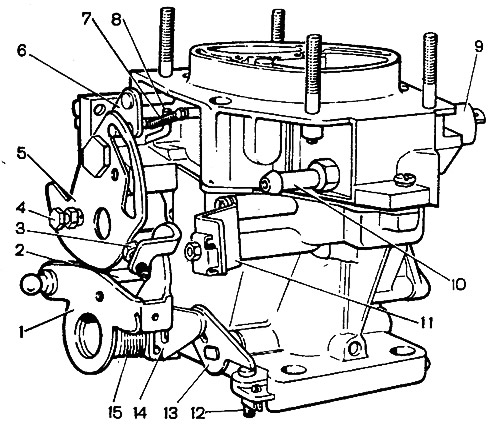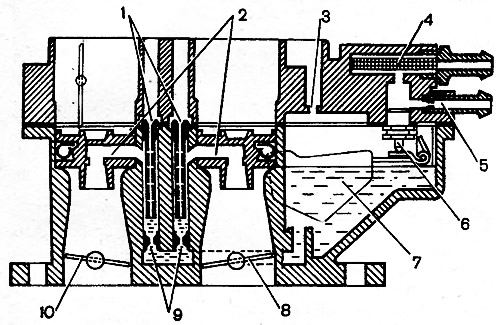
Pic. 9-5. The appearance of the carburetor 21073-1107010: 1 - throttle actuator lever; 2 - pin of the lock lever of the second chamber; 3 - adjusting screw for slightly opening the throttle valve of the first chamber; 4 - screw for fastening the air damper drive rod; 5 - air damper control lever; 6 - air damper lever; 7 - air damper return spring; 8 - diaphragm rod of the starting device; 9 - electromagnetic shut-off valve; 10 - fuel supply pipe; 11 - bracket for fastening the shell of the draft of the air damper drive; 12 - adjusting screw of the second chamber, 13 - throttle lever of the second chamber; 14 - throttle actuator lever of the second chamber; 15 - throttle return spring of the first chamber.
The carburetor has two main dosing systems of the first and second chambers, an idle system of the first chamber with a transition system, a transition system of the second chamber, an economizer of power modes, an econostat, a diaphragm accelerator pump, a starting device. At forced idle, the forced idle economizer is activated.
Calibration data for the carburetor are shown in Table 9-2.
Table 9-2. Carburetor calibration data 21073-1107010

Main dosing system
Fuel through strainer 4 (pic. 9-6) and needle valve 6 is fed into the float chamber. From the float chamber, the fuel enters through the main fuel jets 9 into the emulsion wells and mixes with air leaving the emulsion tubes 1, which are made integral with the main air jets. Through the sprayers 2, the fuel-air emulsion enters the small and large diffusers of the carburetor.

Pic. 9-6. Scheme of the main dosing systems of the carburetor 21073-1107010: 1 - main air jets with emulsion tubes; 2 - sprayers of the first and second chambers; 3 - balancing hole; 4 - fuel filter; 5 - branch pipe with a calibrated hole for draining part of the fuel into the fuel tank; 6 - needle valve; 7 - float; 8 - throttle valve of the second chamber; 9 - main fuel jets; 10 - throttle valve of the first chamber.
Throttle valves 8 and 10 are interconnected in such a way that the second chamber begins to open when the first is already open by 2/3 of the value.
Idle system
The idle system takes fuel from the emulsion well after the main fuel jet 7 (pic. 9-7). The fuel is supplied to the fuel jet 2 with an electromagnetic shut-off valve 1, at the outlet of the jet it is mixed with air coming from the flow channel and from the expanding part of the diffuser (to ensure the normal operation of the carburetor when switching to idle mode). The emulsion exits under the throttle valve through a hole regulated by a quality screw 9 (composition) mixtures.

Pic. 9-7. Scheme of the idle system and transition systems of the carburetor 21073-1107010: 1 - electromagnetic shut-off valve; 2 - idle fuel jet; 3 - idle air jet; 4 - fuel jet of the transition system of the second chamber with a tube; 5 - air jet of the transition system of the second chamber, 6 - outlet of the transition system of the second chamber; 7 - main fuel systems; 8 - slot of the transition system of the first chamber; 9 - quality adjusting screw (composition) idle mixture.
Transition systems
When the carburetor throttle valves are opened before the main metering systems are turned on, the air-fuel mixture enters:
- into the first mixing chamber through the idle jet 2 and the vertical slot 8 of the transition system, located at the level of the throttle valve edge in the closed position;
- into the second mixing chamber through the outlet 6, located just above the edge of the throttle valve in the closed position. Fuel comes from jet 4 through a tube, mixes with air from jet 5 coming through the flow channel.
Power mode economizer
The power mode economizer operates at a certain vacuum behind the throttle valve 5 (pic. 9-8). Fuel is taken from the float chamber through ball valve 8. Valve 8 is closed as long as the diaphragm is held by vacuum in the intake pipe. With a significant opening of the throttle valve, the vacuum drops somewhat and the diaphragm spring 7 opens the valve. The fuel passing through the economizer jet 9 is added to the fuel that passes through the main fuel jet 4, enriching the combustible mixture.

Pic. 9-8. Scheme of econostat and economizer of power modes: 1 - throttle valve of the second chamber; 2 - main fuel jet of the second chamber; 3 - econostat fuel jet with a tube; 4 - main fuel jet of the first chamber; 5 - throttle valve of the first chamber; 6 - vacuum supply channel; 7 - economizer diaphragm; 8 - ball valve; 9 - economizer fuel jet; 10 - fuel channel; 11 - air damper; 12 - main air jets; 13 - econostat injection tube
Econostat
The econostat operates at full engine load at speeds close to maximum, with fully open throttle valves. Fuel from the float chamber through jet 3 (see fig. 9-8) enters the fuel pipe and is sucked out through the injection pipe 13 into the second mixing chamber, enriching the combustible mixture.
Accelerator pump
Diaphragm accelerator pump, mechanically driven by cam 6 (pic. 9-9) on the axis of the throttle valve of the first chamber. When the throttle valve is closed, the spring takes the diaphragm 3 back, which leads to filling the pump cavity with fuel through the ball valve 8. When the throttle valve is opened, the cam acts on the lever 5, and the diaphragm 3 pumps fuel through the ball valve 2 and sprayer 1 into the carburetor mixing chamber, enriching combustible mixture.
The performance of the pump is not adjustable and depends only on the profile of the cam.

Pic. 9-9. Carburetor accelerator pump diagram 21073-1107010: 1 - atomizer; 2 - ball fuel supply valve; 3 - pump diaphragm; 4 - pusher; 5 - drive lever; 6 - pump drive cam; 7 - throttle valve of the first chamber; 8 - check ball valve; 9 - throttle valve of the second chamber.
Starting device
Lever 4 (pic. 9-10) air damper control has three profiles. Its outer edge 4.3 acts on the throttle control lever 11 through the adjusting screw 10 and provides a cold engine start and further increase in the engine crankshaft speed. a certain amount. When the choke lever 4 is turned counterclockwise, the expanding groove releases the pin of the choke lever 6, and the damper will be held fully closed by the return spring 7. At the same time, lever 4 with edge 4.3 slightly opens the throttle valve of the first chamber.

Pic. 9-10. Carburetor starter diagram 21073-1107010: 1 - diaphragm; 2 - adjusting screw; 3 - diaphragm rod; 4 - air damper control lever; 4.1 - lower profile of the groove of the lever 4 to limit the maximum opening of the air damper; 4.2 - the upper profile of the groove, which provides mechanical opening of the air damper; 4.3 - the edge of the lever 4 to ensure the starting clearance of the throttle valve of the first chamber; 5 - air damper; 6 - air damper lever; 7 - air damper return spring; 8 - air damper drive rod; 9 - adjusting screw stopper; 10 - adjusting screw for slightly opening the throttle valve of the first chamber; 11 - throttle actuator lever; 12 - throttle valve of the first chamber; B - starting clearance at the air damper, C - starting clearance at the throttle valve
The axis of the air damper 5 is displaced, therefore, after starting the engine, the air damper can be slightly opened by the air flow, stretching the spring 7, which ensures the lean mixture.
The vacuum due to the throttle space acts on the diaphragm 1 and the rod 3 slightly opens the air damper. Adjusting screw 2 allows you to adjust the amount of opening of the air damper.
The maximum amount of opening of the air damper when starting and warming up the engine depends on the intermediate positions of the lever 4 of the air damper control or on the width of the groove of this lever.
Forced idle economizer
The overrun economizer disables the overrun idle system (during engine braking, when driving downhill, when shifting gears), excluding the release of carbon monoxide into the atmosphere.
In forced idle mode at a crankshaft speed of more than 2100 min-1 and when closed on «mass» limit switch 1 (see fig. 9-26) carburetor (pedal released) shut-off solenoid valve 4 is switched off, the fuel supply is interrupted.
With a decrease in the frequency of rotation of the crankshaft at forced idle to 1900 min-1 the control unit includes a solenoid shut-off valve (even though the limit switch is on «mass»), the fuel supply begins through the idle jet, the engine gradually enters the idle mode.
Blocking of the second mixing chamber of the carburetor
The throttle valve of the second chamber can only be opened when the air damper is open with the second chamber lock lever installed on lever 1 (see fig. 9-5). When the throttle valves are opened, the lock lever acts through the lever 14 of the throttle valve drive of the second chamber on the throttle lever 13 of the second chamber.
When closing the air damper, lever 5 with its outer edge acts on pin 2 of the lock lever and disconnects it from lever 14. In this position, the throttle valve of the second chamber is blocked and cannot be opened.
